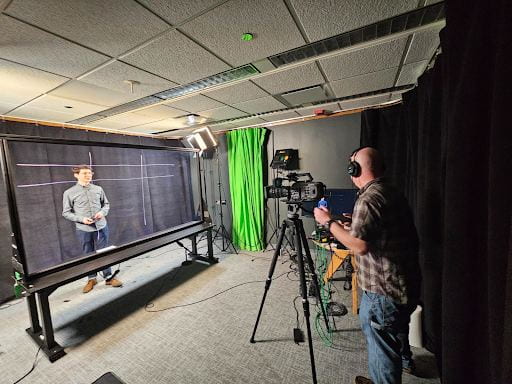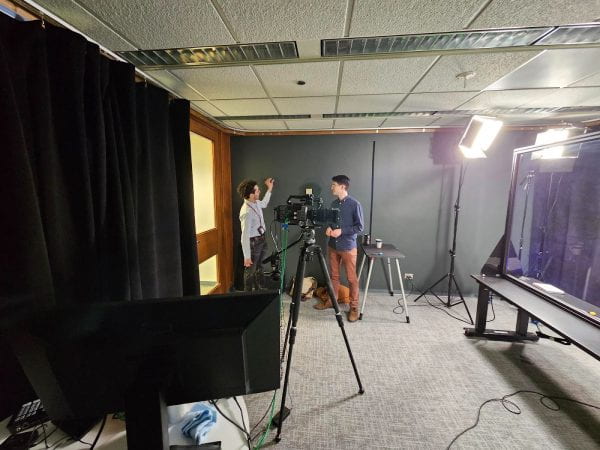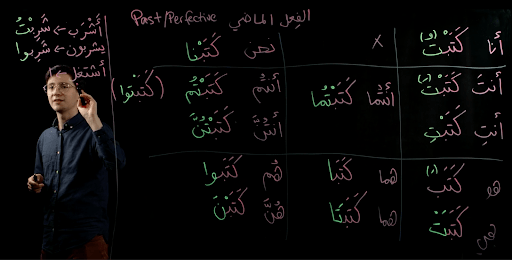What is the Lightboard?
The Lightboard is a panel of glass that you can write on. If you use neon-colored whiteboard markers and shine light into the middle of the panel, the neon ink appears to glow. When you combine this with some camera tricks and video editing, the Lightboard can be a very engaging medium for instruction, offering certain advantages that traditional lecture videos with chalkboards or whiteboards do not.
When you write on a traditional classroom chalkboard or whiteboard, you are facing away from the camera, and your body blocks some of the content that is being written. You may also pause your speech to the camera to write, interrupting your train of thought.
To work around these problems, Northwestern McCormick School of Engineering Professor Michael Peshkin developed the Lightboard. This tool allows an instructor to create video lectures and directly interact with handwritten notes and diagrams while facing the camera to give a more personalized experience. You can give the same sort of visual presentation you would with a chalkboard or whiteboard, without the interruption of turning to and from the camera.

Aidan Kaplan, Assistant Instructional Professor of Arabic, is drawing a chart on the lightboard while Andy Poulos, Multimedia Specialist, checks the settings of the video in the studio. Photo by Academic Technology Solutions.
How can faculty use the lightboard for teaching?
One great benefit of the Lightboard is that any faculty member or instructor can make brief, quick video lectures for their students without extensive use of animations and graphics. Professor Peshkin explains that he wanted to ensure “the students could see me looking at them, they could see my hands, they could clearly read what I’m writing.” Lightboard technology allows faculty to innovate in pedagogy by producing new and exciting videos inside and outside of the traditional classroom environment.
Faculty and instructors from across the University of Chicago can work with ATS to use the Lightboard studio in the A-Level of the Regenstein Library for a range of purposes, such as (but not limited to):
- Diagramming sentence structures, verb conjugations, etc. in a language course
- Representing abstract concepts visually
- Drawing links between different points to construct concept maps
- Recording asynchronous presentations
Faculty have also used the Lightboard as part of larger strategies of flipped classrooms, hybrid courses, specialized MOOC videos, distance learning courses, and to create short pieces to answer student questions. Faculty across the nation have created Lightboard videos for many different disciplines, ranging from ancient languages, to physics, to economics and medicine.
Once produced in our studio, Lightboard videos can be distributed through UChicago Canvas using Panopto. Students can pause, fast-forward, and rewind videos, which gives them the ability to learn at their own pace–a useful supplement to in-class instruction. Lightboard videos can also add a personal connection to asynchronous videos because the instructor speaks and looks directly into the camera, simulating the feeling of a one-on-one conversation. This can help increase engagement, as the viewer can connect with the material and instructor more deeply.
What are some important things to prepare for?
If you are interested in using the lightboard but are unsure how to plan for it, consider the following points to help you organize your thoughts. You do not need to have all the answers beforehand, but having some ideas will help foster a productive discussion with the ATS instructional designers.
- What are the most important topics or concepts that you want to convey to your students? What concepts do they often get stuck on that might require additional explanation?
- Our lightboard is 8 feet long and 4 feet tall. Think about where you will stand and where you will write so that you can use the space efficiently.
- As the board fills up, we will take breaks to clean it and set up the next shoot. Knowing how much information you want to present will help us plan out how many video shoots and segments will be needed.
- Ideally, videos for asynchronous viewing should be 8 to 12 minutes long, so think about how you can break complex concepts into roughly10-minute segments, or “chunks,” for recording.
How can I get started?
If you have questions about the Lightboard or want to set up a meeting, the Learning Design Team is dedicated to helping you develop your initial ideas. Please feel free to contact us! Request an instructional design consultation with LDT instructional designers or join us in office hours, virtual or hybrid, during which you can ask any questions you may have.

Aidan Kaplan, Assistant Instructional Professor of Arabic, and Michael Hernandez, Instructional Designer, discuss how to present concepts on the lightboard. Photo by Academic Technology Solutions.
Further Lightboard Resources
- Learn more about the Lightboard
- Hear Northwestern Professor Michael Peshkin describe the creation and features of his Lightboard (video)
- Stop by ATS office hours or book an appointment with an Instructional Designer to find out if the Lightboard is right for your next project.

